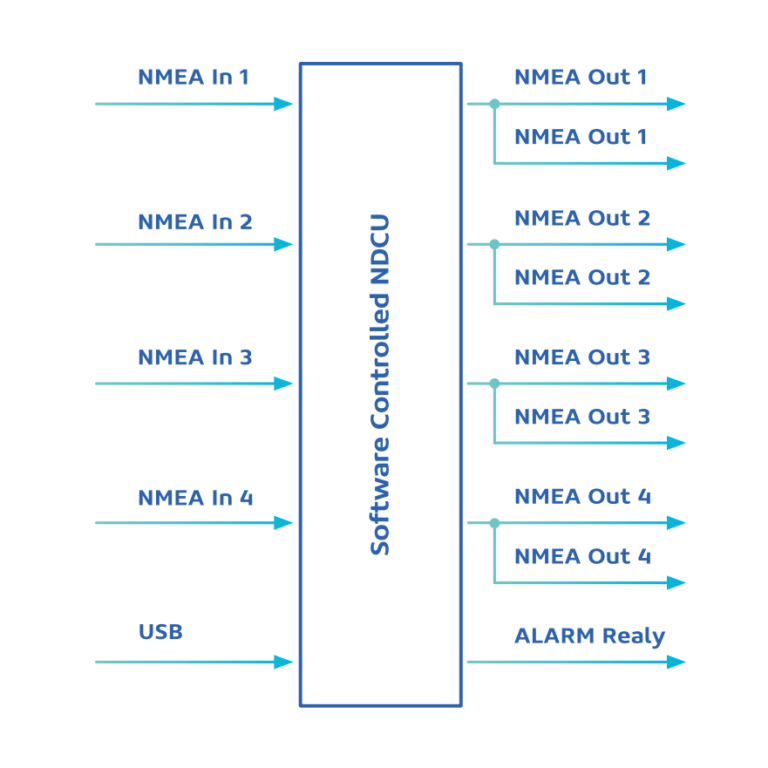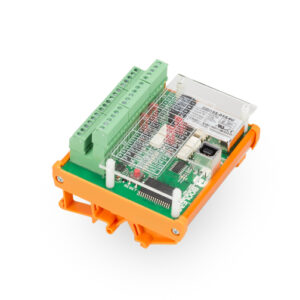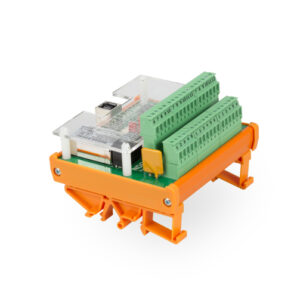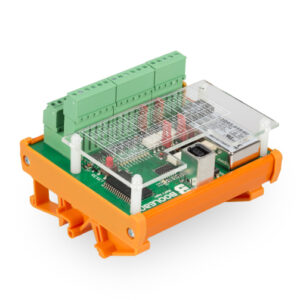
NDCU - Navigation Data Computing Unit
NDCU – Navigation Data Computing Unit is a universal device to receive and transmit RS422 signals such as NMEA 0183, Course Bus or other similar serial protocols with baud rate up to 115200 bps. The device is equipped with four independent serial inputs and four independent serial outputs, USB port which can be used not only for configuring the device but also for listening of the signals, and a fully configurable relay.
Depending on the software uploaded by the user it allows to simple manipulate, filter, combine NMEA strings, making calculations and changing NMEA talkers or even protocols!
Multipurpose, flexible device
Simple and compact design
Easy installation on the DIN rail
Each NMEA input is separated from other connected NMEA devices
Four inputs with separately configurable baud rate
Four outputs with two channel buffers – so two receivers can be safely connected to each output
Standard USB port for programming the device or listening signals
Fully configurable relay (alarm, BNWAS reset or any other purpose)
Software upload by USB port and standard PC computer
Available software
Multiplexer / Demultiplexer
Combine up to 4 NMEA inputs into one output, with galvanic isolation between signals, power supply, and listeners. The multiplexer allows for separate input and output baud rates for each input. Filtered telegrams prevent output line overload in slow baud rate mode, and users can manually select forwarded strings. The unit operates at baud rates from 2400 to 115200 bps and a power supply range of 9 to 36 VDC. The main advantage is the Demultiplexer option, enabling the transfer of important strings from the Navigation Bridge to the Engine Room over a single wire pair, then splitting them back to 4 lines, regardless of baud rate!
True Wind Calculator
Calculate True Wind Angle and Speed. Once MWV (Relative Wind) is received and Gyro with GPS signals are valid, system transmits calculated MWD or MWV (True Wind) string immediately after. True Wind transmission frequency is related to received MWV (Relative Wind) telegrams. If Wind Sensor transmits MWV telegrams with frequency 5Hz (5 times per second) system retransmits data with the same frequency together with calculated True Wind telegrams for every received MWV string.
HDC - Heading Data Converter
Convert Raytheon Anschutz Coursebus (STD20, STD22) data into IEC 61162-2 NMEA Superfast (50Hz) 38400 bps. Unit has preconfigured input/output baud rate and operates with power supply range from 9 to 36 VDC. NDCU transmits HEHDT and HEROT telegrams every time Coursebus telegram is received. With not interrupted Coursebus transmission NMEA telegrams are transferred 50 times per second, so exactly the same rate as Raytheon Anschutz telegrams.
NMEA Superfast to Coursebus Converter
Convert gyrocompass NMEA Superfast (38400 bps, 50Hz) heading to Raytheon Anschütz Coursebus format. The unit has preconfigured input/output baud rates and operates with a power supply range from 9 to 36 VDC. The NDCU must receive HDT and ROT telegrams to convert the signal to Coursebus format. With uninterrupted NMEA Superfast transmission, Coursebus telegrams are transferred 50 times per second, matching the original Raytheon Anschütz telegram rate exactly.
CUSTOM SOFTWARE
Do you need a custom software? Please feel free to contact us. We can design and deliver personalized solutions that align with the your requirements.
Technical data
- Power Supply: 24VDC (9 to 36VDC)
- Power consumption: maximum 7,5 W at 24VDC
- Galvanic isolation of power supply 1,5kVDC
- Galvanic isolation signal input/output: up to 5kVRMS
- Number of inputs: 4, baud rate configured separately
- Number of outputs: 4 the same baud rate as a relevant input
- Input/output signal speed: Up to 115200 bps
- Connection: cables diameter up to 1,5mm2
- Data retention: 20 years at 85 °C / 100 years at 25 °C
- Warranty: 24 months






